On the last day of summer and then on the first few days of fall, I was pleasantly surprised to realize that there were still many butterflies brightening up the forest and meadows in Mississauga. And as October progresses, each four-winged wonder I see basking or dancing around the flowers seems like a victory against the upcoming bleakness of winter. Here’s a few of my favourite butterflies seen at Riverwood and the Rattray recently.
What Dime-Sized Blue Butterfly Is Bobbing Around Near the Grasses?
This is an Eastern Tailed Blue. You can see the “tails” are actually just little extensions at the bottom of the hind wings. That’s great for me because without them I get confused. There are other small blue butterflies, including Summer Azures, that are more difficult to id.
According to the Canadian Biodiversity Information Facility Butterflies of Canada page, Eastern Tailed Blues eat, among other things, white sweet clover, red clover and cow vetch. They are quite common in southern Ontario but less so in other parts of the province.(They are also visually very similar to Western Tailed Blues which are not yet found in southern Ontario.)
The ROM Field Guide says that the caterpillars of these butterflies often rest cozily inside seed pods waiting for spring to continue to mature. I’ll try to keep that comforting image in mind when the snow has buried all of the clovers and vetches knee-deep this winter.
What Is this Large Brown Butterfly with Yellow Edges and Blue Spots Basking on a Tree Trunk?
One of the best sights of spring in the forest is the first appearance of a Mourning Cloak butterfly. These showy Monarch-sized butterflies often over-winter are mature butterflies, tucked into a crevice in a tree trunk. They like to get a jump-start on the tree leaves the caterpillars eat by emerging in early spring, often while the snow is still melting, to mate and lay their eggs.
That may explain why I’ve seen several Mourning Cloaks recently: they are probably the ones that will “sleep over.” If you’re specifically looking for one, check closely in sunny spots in the forest, in spring or fall, particularly near willows and cottonwoods.
Why You Should Always Check a Sap Tree for Butterflies
There is an old oak on the main path at Riverwood Conservancy in Mississauga that often suffers from splits in the bark near the base. Sap is exposed and the insects home in on it happily. I have found quite a variety of butterflies, moths, beetles, bees and wasps on this tree at various times.
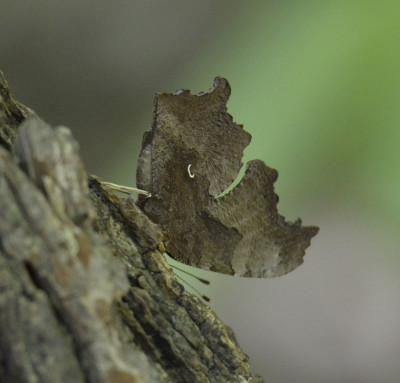
On the last day of summer, I approached it from the shady side and noticed this unlikely shape in silhouette: yes, it’s a butterfly not a dead leaf, despite its leafy edges and colouring. Specifically, it’s some type of Comma butterfly, although I cannot tell you which kind. Despite reading the Butterflies of Ontario, I still can’t tell them apart yet.
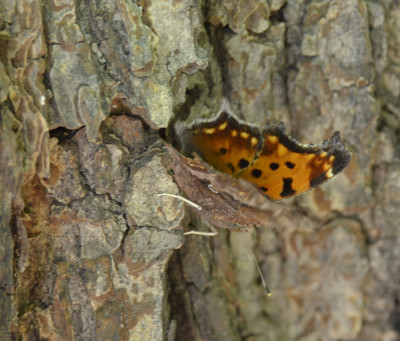
Commas are great at playing the camouflage game. When they close their wings, they have mottled drab wings with an irregular shape that blends quite well with dead leaves and some types of bark. When they want to get noticed, though, they can open their wings to display a lovely combination of orange and dark markings.
What Is This Brown Butterfly with All the Eye Spots Basking in the Sun on a Pile of Dead Leaves?
Beside the sap tree, I saw this Northern Pearly Eye butterfly duck away. I waited and within a minute or two, it returned to continue basking. There are some other butterflies with similar wing markings but so far all I’ve seen at Riverwood are these ones.
Given that I’ve always seen it in the forest, I just assumed that the caterpillars of Northern Pearly Eye’s ate leaves. I was surprised to read in the ROM guide that they actually eat woodland grasses!
The Mysterious Dark Brown Skippers of Summer
A large group of butterflies belong to a family called the skippers. Within this group there are a dozen or so Ontario butterflies with dark wings, little white or tan spots, and lighter brown patches. To a beginner, like me, many of them look much the same. It doesn’t help that the wing colours fade with time or that sometimes the males and females have different markings.
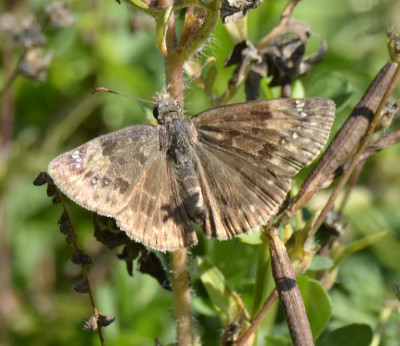
In the hopes that some day I will get better at this identification game, I try to take a photo (ok a dozen photos) of each kind I see. And I always admire them no matter what kind they are. This was one that was getting a sweet sip of nectar from an early autumn aster on the last day of summer.
A Dark Skipper That Has a Bright White Spot to Make It Easy to Identify
Unlike those other skippers, this Silver-spotted Skipper is easy to identify. It really wanted its photo taken: it kept following me, not preceding me, down the path and each time I stopped to look at a bird or Monarch it stopped beside me to show off!
Do the Bright Yellow Sulphur Butterflies Start Migrating in Late Summer
Monarchs may get all the press but other butterflies migrate too. Some types of Sulphur butterflies, which many people think of as yellow versions of the common Cabbage White butterfly, also migrate south at the end of summer and beginning of fall.
This Sulphur treated me to a good look when it stopped for a drink on some asters. They often are moving swiftly at this time of year which can make taking a photograph difficult. I did take some photos as it flew, though, because it’s much easier to identify the type of Sulphur from the top of the wings than from the underside, at least for me. Based on the extensive orange on the upper fore wing, and the yellow dots and dashes in the black wing border, I think this is a female Orange Sulphur.
The ROM field guide says that Orange Sulphurs are “somewhat migratory.” It says that it is suspected that we have to wait for Orange Sulphurs to arrive here from the warmer southern states each spring to start our Ontario populations. It does not say whether our butterflies move south in fall. They are reported at various Hawk Watch border crossings in the fall but I’m not clear whether they were seen moving south or just in the fields at the watch sites.
I’m not sure how long I’m going to get to keep finding butterflies this fall but while it lasts, I’m going to admire them.
Related Reading
- Hunting for Butterflies
- What Thumbnail-sized Blue Butterfly Is Perched on this Goldenrod Blossom
- June Butterflies Along the Credit
Join In
Have you been surprised at how late you’ve seen butterflies? Please share your fall favourite with a comment.

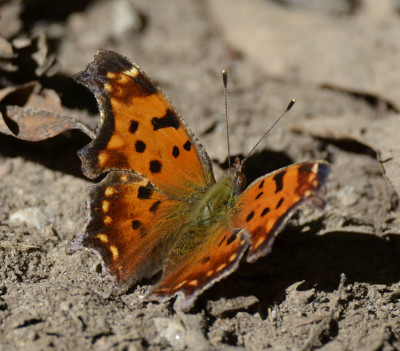
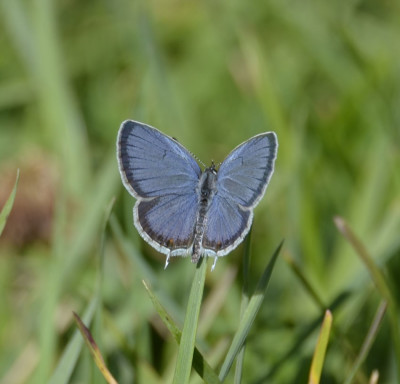

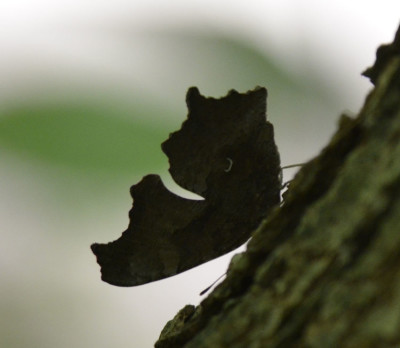
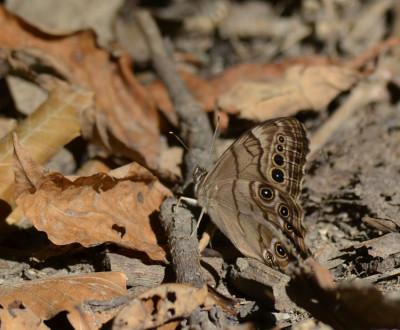
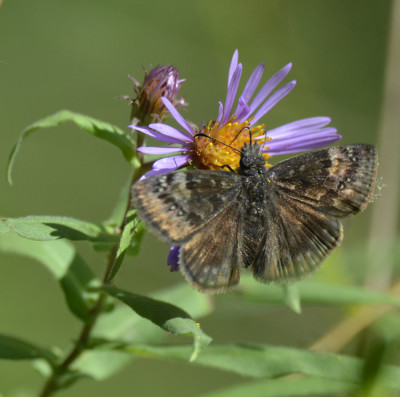
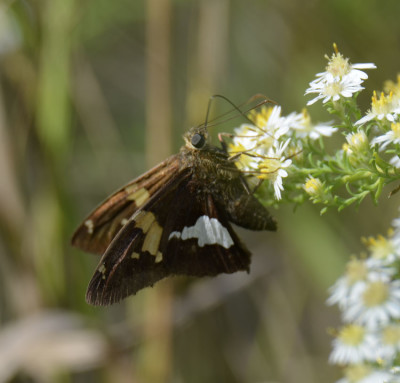

We have a houseboat and have been out on the TN River this weekend. I have been in awe of the number of little yellow butterflies that have migrated from the western shore of the River across tot he Eastern Shore. This has been going on for 3 days now, but slowing down. I kept thinking that one would not make it all the way across such a large span of water, but I haven’t seen one that didn’t make it to the other side. Just amazing little creatures!
That must be quite something to watch. Thanks for sharing!
I started noticing these beautiful little flyers years ago in North Carolina. Now when I see them at the end of summer and know them to be a true sign that summer is ending.Love them ;they are so pretty.
I wish they didn’t mean the end of summer but they are lovely!